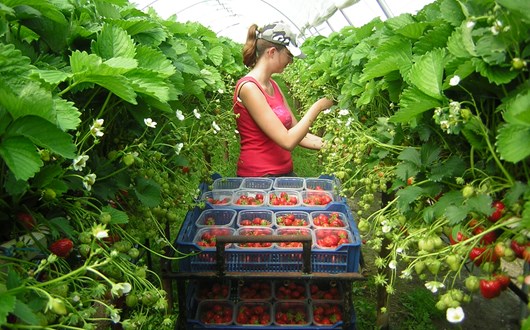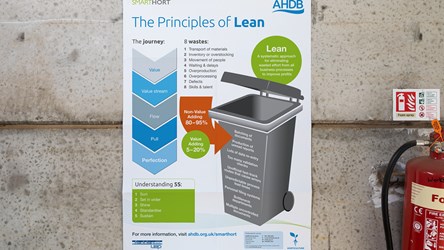Please click here to access the main AHDB website and other sectors.
- Home
- Getting the most from your workforce
Getting the most from your workforce
Now that your workforce is in place and they’re fully trained to do the job, the next important consideration is how you can get the most from them.
Any way in which you can maximise the productivity of your workers will be important and our SmartHort campaign gives you the hints and tips on how to do just that.
Motivating your staff
Motivating your workforce is key to ensuring that they are working at maximum capacity but, vitally, also to the correct standard. This is where concepts like ‘Champion’ pickers and supervisors come in. By identifying those in your business who constantly perform above average, you can use them to motivate and upskill the rest of your workforce.
This article will give you ideas to help you get started with identifying your ‘Champions’. You can also watch the Champion soft fruit picker training video to see some of the techniques in practice.
Read an interview with Chris Rose explaining the Champion approach to labour productivity
Use Lean to make processes as efficient as possible
One of the main focuses of our work in SmartHort has been around Lean techniques and principles. Lean is a technique that originated in the Japanese automotive industry and aims to eliminate all activities that don’t ‘add value’ to a process. It defines the non-value-adding processes as ‘waste’.
Using the key principles of Lean, you can identify where there is waste in your production system so you can focus on the parts that add value – or the parts the customer is willing to pay for! If you are introducing Lean into your business, or are already using the techniques, then this poster is a useful reference to remind you of the guiding principles of Lean management.
Identifying wastes
Considering the different types of wastes that are present in your business is a great place to start if you have no experience of using Lean. In some cases, it is thought that as much as 95% of activities within a process are waste. The wastes can traditionally be categorised into eight areas, which can be remembered by using the acronym TIMWOODS:
- Transport of materials
- Inventory or overstocking
- Movement of people
- Waiting and delays
- Overproduction
- Over-processing
- Defects
- Skills and talent
Transport – Physically moving product around an operation, e.g. forklift trucks moving things from one place to another, or tractors moving product between fields.
Inventory – The amount of stock that you have, and in some cases overstocking of it. This could be overstocking of packaging, labels, growing media, etc.
Movement of people – Individuals moving to get tools or equipment that they need to carry out the operation, e.g. walking to get trays to place harvested fruit.
Waiting – People, product or resources waiting to be able to carry out the process or job, e.g. waiting in line for picked fruit to be scanned and weighed by a supervisor or waiting for a line to be set up correctly in the packhouse.
Overproduction – Producing more product than you can sell or doing something before it is needed.
Over-processing – Performing activities that don’t add customer value or exceed it, e.g. inspecting a product over and above what is required.
Defects – Activities not completed to the correct standard or that don’t meet the customer specification, e.g. paperwork not completed properly with the correct information, or defects with the product itself, such as bruising/out-of-specification size.
Skills – Not using the skills and talent of the workforce appropriately, e.g. where people are being employed to carry out a specific task but their talent and ability would be better used in another role.
When you start to think about TIMWOODS more and recognise the sorts of examples within your own business, it is a really useful way to begin to see the type of waste that is occurring. By identifying these different types of waste, it will allow you to see them much more clearly and start to think about how the non-value-added processes, or wastes, can be reduced.
Lean in practice
For the last 12 months, we have been working with three horticultural businesses through our Strategic SmartHort Centres. As a result of changes made, businesses are projecting productivity improvements of up to 40%. You can read more about which Lean techniques we have been using in this article, following our first workshop with Volmary Ltd.
Key principles and techniques that we covered were process mapping, waste walks, activity sampling, prioritisation matrices and action plan development. You can see photos and examples of how these were done at each of our Strategic SmartHort Centre pages:
- Volmary Ltd (plant propagators in Cambridgeshire)
- Haygrove Ltd (soft fruit growers in Herefordshire)
- Thomas Thomson (soft fruit and tree fruit growers in Blairgowrie)
Earlier this year, Willie Russell from Easter Grangemuir Farm in Fife wrote an article for us to explain what value he had got as a result of implementing Lean into his field vegetable business. You can read more on his thoughts in the Spring 2020 issue of The Grower.
The importance of plan, do, check, act
If you’re introducing Lean principles into your fruit picking, packhouse lines or workplace organisation, good communication is key to the success of implementing new processes and altering ways of working. Without everyone understanding the reasons for a change being introduced and why it is beneficial to both the individual and the business, it will be hard to embed new processes. This article has some useful advice for how to start with small incremental changes and to follow the idea of ‘plan, do, check and act’ (PDCA).
PDCA: how to make successful changes to your business
Further resources
There are a number of articles linked to Lean and labour efficiency on the AHDB SmartHort page. We are also working hard to develop further practical resources and ‘how-to guides’ that can be used by businesses to start to implement Lean. We will be updating this page as soon as they are available.
To find out more about Lean in horticulture, please contact Gracie Emeny.



